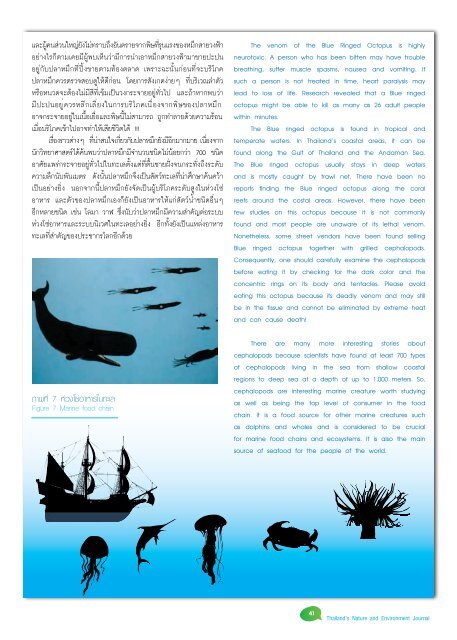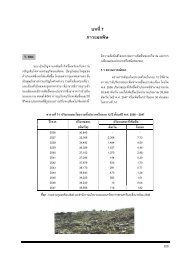ปีที่ 5 ฉบับที่ 3 กรกฎาคม-กันยายน 2552 - สำนักงานนโยบายและแผน ...
ปีที่ 5 ฉบับที่ 3 กรกฎาคม-กันยายน 2552 - สำนักงานนโยบายและแผน ...
ปีที่ 5 ฉบับที่ 3 กรกฎาคม-กันยายน 2552 - สำนักงานนโยบายและแผน ...
You also want an ePaper? Increase the reach of your titles
YUMPU automatically turns print PDFs into web optimized ePapers that Google loves.
และผู ้คนส่วนใหญ่ยังไม่ทราบถึงอันตรายจากพิษที ่รุนแรงของหมึกสายวงฟ้า<br />
อย่างไรก็ตามเคยมีผู้พบเห็นว่ามีการนําเอาหมึกสายวงฟ้ามาขายปะปน<br />
อยู่กับปลาหมึกที่ปิ้งขายตามท้องตลาด เพราะฉะนั้นก่อนที่จะบริโภค<br />
ปลาหมึกควรตรวจสอบดูให้ดีก่อน โดยการสังเกตง่ายๆ ที่บริเวณลําตัว<br />
หรือหนวดจะต้องไม่มีสีที่เข้มเป็นวงกระจายอยู่ทั่วไป และถ้าหากพบว่า<br />
มีปะปนอยู่ควรหลีกเลี่ยงในการบริโภคเนื่องจากพิษของปลาหมึก<br />
อาจกระจายอยู่ในเนื้อเยื่อและพิษนี้ไม่สามารถ ถูกทําลายด้วยความร้อน<br />
เมื่อบริโภคเข้าไปอาจทําให้เสียชีวิตได้ !!!<br />
เรื่องราวต่างๆ ที่น่าสนใจเกี่ยวกับปลาหมึกยังมีอีกมากมายเนื่องจาก<br />
นักวิทยาศาสตร์ได้ค้นพบว่าปลาหมึกมีจํานวนชนิดไม่น้อยกว่า 700 ชนิด<br />
อาศัยแพร่กระจายอยู่ทั่วไปในทะเลตั้งแต่ที่ตื้นชายฝั่งจนกระทั่งถึงระดับ<br />
ความลึกนับพันเมตร ดังนั้นปลาหมึกจึงเป็นสัตว์ทะเลที่น่าศึกษาค้นคว้า<br />
เป็นอย่างยิ่ง นอกจากนี้ปลาหมึกยังจัดเป็นผู้บริโภคระดับสูงในห่วงโซ่<br />
อาหาร และตัวของปลาหมึกเองก็ยังเป็นอาหารให้แก่สัตว์น้ําชนิดอื่นๆ<br />
อีกหลายชนิด เช่น โลมา วาฬ ซึ่งนับว่าปลาหมึกมีความสําคัญต่อระบบ<br />
ห่วงโซ่อาหารและระบบนิเวศในทะเลอย่างยิ่ง อีกทั้งยังเป็นแหล่งอาหาร<br />
ทะเลที่สําคัญของประชากรโลกอีกด้วย<br />
ภาพที่ 7 ห่วงโซ่อาหารในทะเล<br />
Figure 7 Marine food chain<br />
The venom of the Blue Ringed Octopus is highly<br />
neurotoxic. A person who has been bitten may have trouble<br />
breathing, suffer muscle spasms, nausea and vomiting. If<br />
such a person is not treated in time, heart paralysis may<br />
lead to loss of life. Research revealed that a Blue ringed<br />
octopus might be able to kill as many as 26 adult people<br />
within minutes.<br />
The Blue ringed octopus is found in tropical and<br />
temperate waters. In Thailand’s coastal areas, it can be<br />
found along the Gulf of Thailand and the Andaman Sea.<br />
The Blue ringed octopus usually stays in deep waters<br />
and is mostly caught by trawl net. There have been no<br />
reports finding the Blue ringed octopus along the coral<br />
reefs around the costal areas. However, there have been<br />
few studies on this octopus because it is not commonly<br />
found and most people are unaware of its lethal venom.<br />
Nonetheless, some street vendors have been found selling<br />
Blue ringed octopus together with grilled cephalopods.<br />
Consequently, one should carefully examine the cephalopods<br />
before eating it by checking for the dark color and the<br />
concentric rings on its body and tentacles. Please avoid<br />
eating this octopus because its deadly venom and may still<br />
be in the tissue and cannot be eliminated by extreme heat<br />
and can cause death!<br />
There are many more interesting stories about<br />
cephalopods because scientists have found at least 700 types<br />
of cephalopods living in the sea from shallow coastal<br />
regions to deep sea at a depth of up to 1,000 meters. So,<br />
cephalopods are interesting marine creature worth studying<br />
as well as being the top level of consumer in the food<br />
chain. It is a food source for other marine creatures such<br />
as dolphins and whales and is considered to be crucial<br />
for marine food chains and ecosystems. It is also the main<br />
source of seafood for the people of the world.<br />
41<br />
Thailand’s Nature and Environment Journal

















